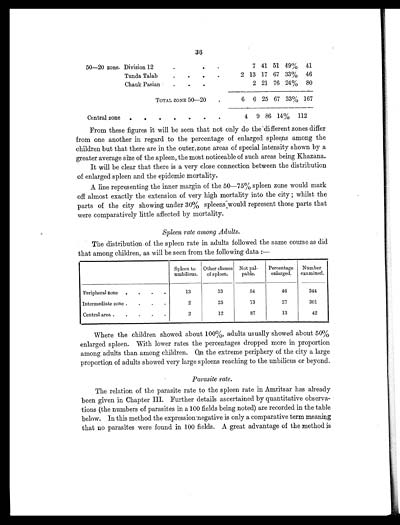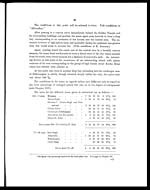Medicine - Institutions > Army health reports and medical documents > Scientific memoirs by officers of the Medical and Sanitary Departments of the Government of India > Number 46 - Malaria in the Punjab > Part II - Autumnal epidemic (fulminant) malaria
(48) Page 36
Download files
Individual page:
Thumbnail gallery: Grid view | List view

36
| 50—20 zone. | Division 12 | 7 | 41 | 51 | 49% | 41 | |||||||
| Tunda Talab | 2 | 13 | 17 | 67 | 33% | 46 | |||||||
| Chauk Pasian | 2 | 21 | 76 | 24% | 80 | ||||||||
| TOTAL ZONE 50—20 | 6 | 6 | 25 | 67 | 33% | 167 | |||||||
| Central zone | 4 | 9 | 86 | 14% | 112 | ||||||||
From these figures it will be seen that not only do the different zones differ
from one another in regard to the percentage of enlarged spleens among the
children but that there are in the outer zone areas of special intensity shown by a
greater average size of the spleen, the most noticeable of such areas being Khazana.
It will be clear that there is a very close connection between the distribution
of enlarged spleen and the epidemic mortality.
A line representing the inner margin of the 50—75% spleen zone would mark
off almost exactly the extension of very high mortality into the city; whilst the
parts of the city showing under 30% spleens would represent those parts that
were comparatively little affected by mortality.
Spleen rate among Adults.
The distribution of the spleen rate in adults followed the same course as did
that among children, as will be seen from the following data :—
| Spleen to umbilicus. |
Other classes of spleen. |
Not pal- pable. |
Percentage enlarged. |
Number examined. |
||||||
| Peripheral zone | 13 | 33 | 54 | 46 | 344 | |||||
| Intermediate zone | 2 | 25 | 73 | 27 | 301 | |||||
| Central area | 2 | 12 | 87 | 13 | 42 | |||||
Where the children showed about 100%, adults usually showed about 50%
enlarged spleen. With lower rates the percentages dropped more in proportion
among adults than among children. On the extreme periphery of the city a large
proportion of adults showed very large spleens reaching to the unbilicus or beyond.
Parasite rate.
The relation of the parasite rate to the spleen rate in Amritsar has already
been given in Chapter III. Further details ascertained by quantitative observa-
tions (the numbers of parasites in a 100 fields being noted) are recorded in the table
below. In this method the expression negative is only a comparative term meaning
that no parasites were found in 100 fields. A great advantage of the method is
Set display mode to: Large image | Zoom image | Transcription
Images and transcriptions on this page, including medium image downloads, may be used under the Creative Commons Attribution 4.0 International Licence unless otherwise stated. ![]()
| Permanent URL | https://digital.nls.uk/75058714 |
|---|
| Shelfmark | IP/QB.10 |
|---|---|
| Additional NLS resources: | |




